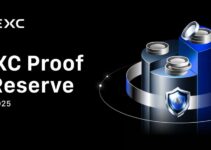Perpetual futures now drive crypto trading, offering high leverage, constant price discovery, and deep liquidity. The old model of trusting centralized exchanges is quickly disappearing. A new wave of decentralized perpetual exchanges, or Perp DEXs, is redefining the market with near-CEX execution, full transparency, user custody, and no KYC.
In 2025, these on-chain platforms handle nearly $1 trillion in monthly volume, capturing about 18% of the global derivatives market. EdgeX, Hyperliquid, and Lighter lead this shift, showing traders can finally combine speed, depth, and self-custody in one platform.
Below, we explain how Perp DEXs work, their main mechanisms, and the platforms shaping the future of decentralized derivatives trading.

Table of Contents
What Are Perpetual DEXs?
A Perpetual DEX is a decentralized platform that lets traders speculate on asset prices using perpetual futures contracts, derivatives with no expiration date. Unlike traditional futures, you can hold a position indefinitely, provided margin requirements are met.
These exchanges run entirely on-chain through smart contracts, giving users complete control of collateral and eliminating the need to trust a centralized intermediary. Every trade, funding rate, and liquidation is verifiable on public ledgers, bringing unmatched transparency to leveraged markets.
Perpetual DEXs emerged after the 2022 collapse of major centralized exchanges, highlighting the risks of custodial trading. They’ve since evolved from early AMM-based models to CLOB (Central Limit Order Book) designs capable of processing hundreds of thousands of orders per second.
How Perpetual DEXs Work
Perp DEXs operate through a set of smart contracts that manage leverage, funding payments, and liquidation logic. Traders deposit collateral (usually stablecoins like USDT or USDC) and open long or short positions on assets such as Bitcoin, Ethereum, or Solana.
Each position is continuously marked to market, and funding rates ensure the contract’s price stays close to spot levels. If the market moves against a trader and margin drops below maintenance level, the smart contract triggers liquidation automatically.
The key components of a Perp DEX are:
- Matching Engine: Executes orders and updates open interest.
- Price Oracles: Deliver real-time asset prices (typically via Pyth or Chainlink).
- Funding Mechanism: Balances long/short demand through periodic payments.
- Liquidation Module: Protects the system from undercollateralized positions.
Fees and Funding Rates Explained
Profitability on Perp DEXs hinges on managing fees and funding costs.
- Trading Fees: Maker fees reward liquidity provision, while taker fees apply to market orders. For instance, EdgeX charges 0.012% maker and 0.038% taker, while Lighter offers zero fees for retail.
- Funding Rates: Regular payments between long and short traders that align perp prices with the spot market. When longs dominate, they pay shorts, and vice versa.
- Liquidation Fees: Deducted when margin falls below maintenance thresholds.
Small differences here matter—active traders can lose or gain thousands in cumulative fees over a month of high-frequency trading.
Risk Management and Liquidations
While Perp DEXs eliminate custody risk, they introduce new forms of smart contract and execution risk.
Liquidations are handled automatically by code. If your position equity drops below the maintenance margin, it’s force-closed to protect the protocol. Some exchanges, like Drift and Aevo, use insurance funds or backstop liquidity modules to absorb bad debt.
Common risk areas include:
- Oracle delays: Can trigger false liquidations during volatility.
- Smart contract bugs: Even audited code can be exploited.
- Excessive leverage: Amplifies both profits and drawdowns.
Professional traders monitor liquidation thresholds and funding exposure continuously to avoid cascading losses.
Perp DEX vs Perp CEX: Key Differences
| Feature | Perp DEX | Perp CEX |
| Custody | User controls collateral | Exchange holds funds |
| Transparency | On-chain, auditable | Opaque internal systems |
| KYC | Usually none | Mandatory |
| Speed | Fast (sub-second on L1s/L2s) | Very fast (microseconds) |
| Risk | Smart contract or oracle risk | Counterparty and custody risk |
| Access | Global, wallet-based | Region-restricted |
CEXs still offer unmatched depth and smoother UX, but Perp DEXs are catching up rapidly, especially with zk-proof validation and custom high-speed chains like Hyperliquid.
How To Choose the Right Perpetual DEX
Selecting a DEX depends on your trading style and priorities. Consider:
- Liquidity Depth: Check open interest and spread data on major pairs.
- Execution Quality: Platforms like Hyperliquid and EdgeX offer near-instant fills.
- Collateral Type: Stablecoin flexibility (USDT, USDC, aeUSD).
- Funding Stability: Low and predictable rates protect PnL.
- Security Audits: Review audit histories and exploit track records.
- Rewards Programs: Points or token incentives can offset costs but should not dictate choice.
Pro tip: Favor venues with verifiable on-chain metrics and published oracle data.
Top Perpetual DEX Platforms in 2025
| Platform | Blockchain | Daily Volume | Leverage | Fees (Maker/Taker) | Highlights |
| Hyperliquid | Custom L1 | $15B | 40x | 0% / 0.05% | Fastest on-chain execution, deepest markets |
| EdgeX | Ethereum L2 | $4.5B | 100x | 0.012% / 0.038% | Deep liquidity, cross-chain aggregation |
| Lighter | Ethereum zk-rollup | $8.4B | 50x | 0% retail / 0.02% pro | zk-verified trades, zero-fee retail |
| Aster | Multi-chain | $10B | 1001x | 0.01% / 0.035% | Binance-backed, extreme leverage |
| Drift | Solana | $300M | 101x | –0.01% / 0.1% | Hybrid AMM + order book |
| dYdX | Cosmos | $270M | 50x | –0.011% / 0.05% | Proven track record, validator-run |
Market Trends and On-Chain Growth
Decentralized perpetual exchanges now account for nearly one-fifth of global perpetual futures volume, a leap from under 4% in 2023. According to Datawallet’s 2025 Perp DEX Market Report, cumulative on-chain trading has surpassed $8.6 trillion, reflecting traders’ growing preference for transparent, self-custodied venues.
Key drivers of this growth:
- CEX trust erosion post-FTX and regulatory crackdowns.
- High-speed L1s/L2s enabling millisecond execution.
- Reward programs and points farming attracting liquidity.
- Institutional adoption through smart contract wallets and compliance modules.
The next battleground will be between Ethereum-aligned chains (Lighter, Aevo, Synthetix) and performance-first appchains (Hyperliquid, Aster).
Conclusion
Perpetual DEXs have evolved from experimental AMMs into fully fledged trading venues competing head-to-head with centralized exchanges. They combine custody, execution, and transparency in one on-chain ecosystem that traders can audit in real time.
As the market matures, the edge will belong to traders who understand funding dynamics, on-chain liquidity, and protocol risk. Platforms like EdgeX, Hyperliquid, and Lighter are proving that the future of derivatives is decentralized, and it’s already here.
Join MEXC and Get up to $10,000 Bonus!
Sign Up


